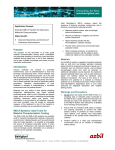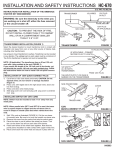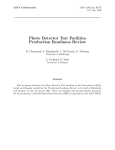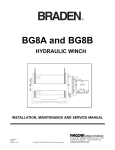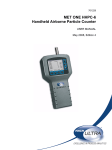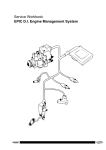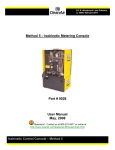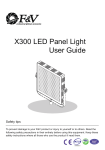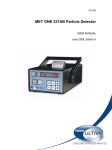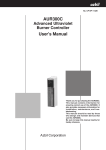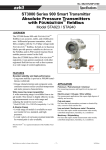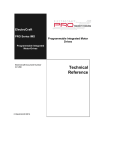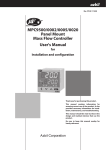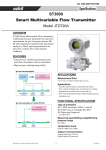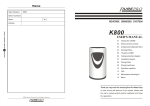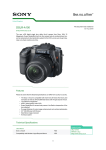Download Compressed Gas Testing
Transcript
Application Note Instantaneous Microbial Monitoring of Compressed Gases Introduction environments. Thus, it is important to know the gas pressure of all the sample points that you wish to test. Compressed air and other gases are used for a range of applications in pharmaceutical and food and beverage manufacturing, including applications involving direct product contact. As such, these gases should be monitored for levels of microbial and ® particulate contamination. Azbil BioVigilant’s IMD-A systems are useful tools for microbial monitoring that offer the advantages of increased sensitivity, instantaneous detection, and real-time reporting, as compared to traditional growth-based methods. Azbil BioVigilant has performed successfully preliminary testing of compressed air systems using a ported HPD manufactured by Lighthouse Worldwide Solutions, shown in Figure 1 (P/N 402-965231_2). Guidelines for microbial monitoring using the IMD-A 350 system in conjunction with this HPD are outlined in this application note. Please contact Azbil BioVigilant’s Applications team for additional guidance if other HPD models or other gases are involved. When used with a high pressure diffuser (HPD) to reduce gas pressure, the IMD-A 350 system is able to sample at a calibrated flow rate of 28.3 LPM (1 CFM), thus enabling detection of microbes from a prespecified volume of gas for accurate quantitation. The IMD-A system uses precision components to maintain a steady flow rate under some degree of both positive and negative pressure loads and any flow deviations will trigger flow alarms to alert the operator. The alarms, if any, are also recorded in the audit trail. Lighthouse Worldwide Solutions Isokinetic HPD HPD outlet: reduced pressure gas flow to IMD-A High Pressure Diffusers A variety of high pressure diffusers are commercially available, and designed to work with particle counters. They are used in between connections to the gas source and the sampling instrument and generally cause a drop in gas pressure by diverting excess gas away from the sampling pathway. Gas may exit directly into the room/ test area through vents in the sides of the HPD (“vented”), or be directed away to another location through a port and tubing (“ported”). Ported HPDs are recommended for situations where air flow disturbances should be minimized and when filtering the exhaust with a HEPA filter is desired. HPDs differ in the specified flow rates of the sampling instruments with which they can be used. For testing with the IMD-A 350 system, it is important to use an HPD that specifies a 28.3 LPM (1 CFM) sampling flow rate. HPDs that specify other flow rates, e.g. 2.83 LPM (0.1 CFM), are not recommended. All HPDs should also have a stated operational range of gas pressure for which they will function correctly, with both minimum and maximum pressure ratings. Exceeding this range could cause inaccurate readings and potentially damage the IMD-A system, whereas operating below the lower limit could cause contamination of samples from air in the surrounding HPD exhaust: excess gas removed and HEPA filtered HPD inlet: high pressure gas in Figure 1: Lighthouse Worldwide Solutions Isokinetic HPD (28.3 LPM) Additional adapters and tubing may be required to connect the HPD to the IMD-A system and to the compressed gas test sources at your facility. For connection to the IMD-350 system, 3/8” ID Bev-A® Line or stainless steel tubing is recommended. BevA-Line tubing at the proper size is available from Azbil BioVigilant. The standard HPD outlet fitting is too small for this tubing so an appropriate adapter is necessary to connect. Adapters and alternative connectors are available from Lighthouse Worldwide Solutions. Information in this document is subject to change without notice. While the information contained herein is believed to be accurate and reliable, Azbil BioVigilant, Inc., assumes no responsibility for errors or omissions. IMD®, IMD-A®, PHARMAMASTER®, BIOVIGILANT®, the BioVigilant logo, and the term Instantaneous Microbial Detection™ are the trademarks or registered trademarks of Azbil BioVigilant, Inc. in the United States and/or other countries. Other names or brands may be the property of others. ©2011 Azbil BioVigilant, Inc. All rights reserved. Printed in U.S.A. Page 2 of 3 Bev-A Line tubing may also be used to connect the HPD to the gas test point; however, adapters for the HPD outlet and connectors appropriate to your specific gas source will also need to be obtained. Azbil BioVigilant tested this application on two compressed air outlets, one with a sanitary flange ® type connector and another with a Swagelok quickconnect fitting. A 3/8” ID Bev-A-Line tubing with quickconnect adapters were used to connect to both the inlet and outlet of the HPD. Figure 2 shows the test setup used during Azbil BioVigilant’s preliminary testing of compressed air. Please contact Azbil BioVigilant if you need assistance in identifying and sourcing connectors and tubing appropriate for your facility. 2. Do not perform testing on hazardous or toxic gases, for example, high percentage or pure oxygen. 3. Follow all instructions detailed in the operating manual for the HPD provided by the manufacturer for its correct use and methods for cleaning and disinfection. 4. Ensure that the pressure of each outlet to be tested is within the operational range of the HPD, e.g. 30-150 PSI. If necessary, measure the pressure using a calibrated pressure gauge. 5. Ensure that all gas to be tested is oil and moisture free, and relatively clean to avoid contaminating the optics within the IMD-A system. This usually involves implementation of oil and moisture filters which are often integrated into compressed air systems. 6. Gases other than air may have additional factors to consider for testing, such as gas temperature and density. Please contact Azbil BioVigilant for assistance. Warnings and Precautions 1. Follow your company’s safety guidelines for appropriate personal protective equipment and procedures for operation of high pressure gas systems to minimize risk of injury and damage to equipment. Ear protection may be necessary. Compressed air pressure gauge Sanitary flange connection to IMD-A IMD-A 350 Double sanitary flange connection to compressed air outlet Figure 2. IMD-A compressed gas monitoring test set-up. www.BioVigilant.com 2005 W. Ruthrauff Road, Suite 151 ▪ Tucson AZ 85705 Telephone (520) 292-2342 ▪ Fax (520) 292-2365 Page 3 of 3 Procedure Clean and decontaminate the HPD, tubing and connectors per the operating manual. Note that the HPD may be cleaned using an ultrasonic bath and may also be disassembled for cleaning and decontamination. After cleaning, ensure that the HPD is completely dry and use appropriate precautions to ensure that the HPD and tubing remain clean during transport to the testing location and set-up. A clean, particle-free bag may be used, and the use of powder-free gloves during testing is recommended. Follow these next steps in the exact order described below to set up the equipment and take a sample. The example setup is shown in Figure 2. Important note: Ensure that the compressed gas is flowing through the system before powering on the IMD-A system using PharmaMaster® interface. The IMD-A system will draw gas into the system as soon as it is powered on and, if the compressed gas is not flowing, air may be drawn into the system through the exhaust port. This could potentially contaminate the HPD and tubing with ambient air or introducing particles by back-flushing the HEPA filter. Similarly, it is important to power the IMD-A system off before closing the compressed gas source. The same issue may be seen if the HPD is used on gas sources with pressure below the manufacturer’s specification (e.g. 30 PSI), and if an attempt is made to purge the HPD and tubing by attaching a HEPA filter to the inlet tubing and starting the IMD-A purge cycle. If these situations occur, the exhaust port may offer the path of least resistance to incoming gas and contaminate the system. 6. Using appropriate connectors and tubing as necessary, connect the HPD to the compressed gas source, ensuring that the gas flow is in the direction of the arrow. 7. Connect tubing from the HPD outlet to the IMD-A sanitary flange and attach to the IMD-A system inlet. 8. Ensure all appropriately. 9. Open the compressed gas source to allow gas (not exceeding the manufacturer’s maximum specification, e.g.100 PSI) to flow through the HPD and into the IMD-A system. Power on the IMD-A system using the PharmaMaster software, and wait until the green light indicates that the system is ready to sample. connections are tightened 10. Verify that gas can is flowing from the exhaust port on the HPD and that gas pressure remains within the manufacturer’s specification, e.g. 30100 PSI range. 11. Allow the system to run for about one minute as a purge of the complete assembly. 12. Take a sample of the desired volume using the PharmaMaster software. 13. Repeat as necessary until the desired number of samples has been taken. 14. Power off the IMD-A system using the PharmaMaster interface prior to closing the valve on the compressed gas source. 15. Close the valve on the compressed gas source. 1. 2. Power on the IMD-A 350 system using the external power switch and launch the PharmaMaster software. Start the IMD-A system using the PharmaMaster software and perform the cleaning procedure per the IMD-A user manual (UM-IMD0009 IMD-A System/ PharmaMaster User Manual). At the end of the procedure, leave the HEPA filter in place on the inlet. Turn off the IMD-A system using the PharmaMaster interface, but do not exit the software. 3. If desired, attach a HEPA filter with tubing to the exhaust port of the HPD to minimize airflow disruptions and contamination to the environment. 4. Verify that gas pressure at the test point is within the manufacturer’s specification (e.g. 30-100 PSI) using a calibrated pressure sensor. 5. Purge the compressed gas line for approximately one minute with the valve fully open. Close the line when completed. 16. Disconnect the HPD and tubing from between the IMD-A system and from the compressed gas test point. 17. Power down the PharmaMaster software, shut down Windows, and power off the IMD-A system using the switch on the unit, per the operating manual. Support Please contact Azbil BioVigilant’s Applications team or your sales executive for additional assistance. LI010 December 27, 2011 www.BioVigilant.com 2005 W. Ruthrauff Road, Suite 151 ▪ Tucson AZ 85705 Telephone (520) 292-2342 ▪ Fax (520) 292-2365



